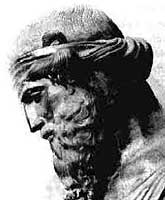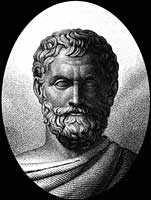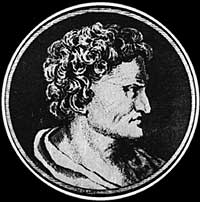ASTRONOMERS
ANCIENT
 ARISTOTLE (384 B.C. - 322 B.C.)
ARISTOTLE (384 B.C. - 322 B.C.)
Aristotle believed that the universe was spherical and finite. He also believed that the earth was a sphere, much smaller than the stars. To support his theory, he used observations from lunar eclipses stating that lunar eclipses would not show segments with a curved outline if the earth were not spherical. Additionally, he stated that when a person travels north or south, they do not see the same night stars, nor do they appear in the same positions in the sky.
Around this time there was a common belief that four basic elements existed: earth, air, fire, and water. In addition to these elements, Aristotle believed that there was a fifth element called aether, which he thought to be the basic make up of the celestial bodies. His view of the universe was hierarchical, and he made a distinct difference between the earth and the heavens.
According to Aristotle's theories of motion, he believed that there were three kinds: rectilinear, circular and mixed. He theorized that the four elements tended to move in straight lines. The earth moved downward; fire moved upward, while water and air fell in between. His fifth element, aether, moved in circles. Aristotle also believed that each planet followed its own specific path.
His hierarchical model of the universe served to greatly influence medieval scholars, who modified it. Aristotle's contribution to astronomy was his ability to ask certain questions about the universe, which served to stimulate others who came after him to find answers.
 DEMOCRITUS (460 B.C. - 370 B.C.)
DEMOCRITUS (460 B.C. - 370 B.C.)
Democritus was born in Abdera, Thrane, and is credited with developing the atomic theory of the universe, which was previously discovered by the Greek philosopher Leucippus.
Democritus's theory stated that the world was composed of hard indivisible particles of matter moving through empty space. He speculated that atoms had shape, mass and motion. He believed that the cosmos were formed by a spinning vortex of atoms and that an infinite amount of worlds was formed in a similar fashion.
 ERATOSTHENES (276 B.C. - 196 B.C.)
ERATOSTHENES (276 B.C. - 196 B.C.)
Eratosthenes was born in Cyrene, now Libya, in North Africa. He was a Greek mathematician, astronomer, geographer and poet, who is credited with measuring the circumference of the earth.
Eratosthenes astronomically determined the differences in latitude between the Egyptian cities of Syene (present day Aswan) and Alexandria. He compared the noon midsummer shadow between the two cities. He believed the sun was so far away that its rays were parallel.With his knowledge of the distance between the two cities, he formulated the circumference of the earth.
His other contributions include a calendar with leap years and a star catalogue that contained 675 stars. He also sketched maps of the route of the Nile to Khartoum and measured the distance to the sun and moon using data collected during lunar eclipses.
 HIPPARCHUS (190 B.C. - 120 B.C.)
HIPPARCHUS (190 B.C. - 120 B.C.)
Hipparchus, born in Nicaea (now Iznik, Turkey), was known for being an important mathematician and astronomer. He calculated the length of a year, as well as creating a star chart which named about 850 stars. Additionally, Hipparchus predicted the positions of the planets, stars and constellations which were used by sailors for navigation. Hipparchus is most famous for the discovery of precession, which is due to the slow change in direction of the axis of rotation of the earth. Hipparchus also made estimations of the distance from the Earth to the moon.